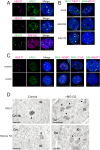SWI/SNF chromatin-remodeling complexes function in noncoding RNA-dependent assembly of nuclear bodies
- PMID: 25831520
- PMCID: PMC4394320
- DOI: 10.1073/pnas.1423819112
SWI/SNF chromatin-remodeling complexes function in noncoding RNA-dependent assembly of nuclear bodies
Abstract
Paraspeckles are subnuclear structures that form around nuclear paraspeckle assembly transcript 1 (NEAT1) long noncoding RNA (lncRNA). Recently, paraspeckles were shown to be functional nuclear bodies involved in stress responses and the development of specific organs. Paraspeckle formation is initiated by transcription of the NEAT1 chromosomal locus and proceeds in conjunction with NEAT1 lncRNA biogenesis and a subsequent assembly step involving >40 paraspeckle proteins (PSPs). In this study, subunits of SWItch/Sucrose NonFermentable (SWI/SNF) chromatin-remodeling complexes were identified as paraspeckle components that interact with PSPs and NEAT1 lncRNA. EM observations revealed that SWI/SNF complexes were enriched in paraspeckle subdomains depleted of chromatin. Knockdown of SWI/SNF components resulted in paraspeckle disintegration, but mutation of the ATPase domain of the catalytic subunit BRG1 did not affect paraspeckle integrity, indicating that the essential role of SWI/SNF complexes in paraspeckle formation does not require their canonical activity. Knockdown of SWI/SNF complexes barely affected the levels of known essential paraspeckle components, but markedly diminished the interactions between essential PSPs, suggesting that SWI/SNF complexes facilitate organization of the PSP interaction network required for intact paraspeckle assembly. The interactions between SWI/SNF components and essential PSPs were maintained in NEAT1-depleted cells, suggesting that SWI/SNF complexes not only facilitate interactions between PSPs, but also recruit PSPs during paraspeckle assembly. SWI/SNF complexes were also required for Satellite III lncRNA-dependent formation of nuclear stress bodies under heat-shock conditions. Our data suggest the existence of a common mechanism underlying the formation of lncRNA-dependent nuclear body architectures in mammalian cells.
Keywords: chromatin-remodeling complex; long noncoding RNA; nuclear bodies; ribonucleoprotein assembly.
Conflict of interest statement
The authors declare no conflict of interest.
Figures





References
-
- Visa N, Puvion-Dutilleul F, Bachellerie JP, Puvion E. Intranuclear distribution of U1 and U2 snRNAs visualized by high resolution in situ hybridization: Revelation of a novel compartment containing U1 but not U2 snRNA in HeLa cells. Eur J Cell Biol. 1993;60(2):308–321. - PubMed
-
- Fox AH, et al. Paraspeckles: A novel nuclear domain. Curr Biol. 2002;12(1):13–25. - PubMed
-
- Prasanth KV, et al. Regulating gene expression through RNA nuclear retention. Cell. 2005;123(2):249–263. - PubMed
Publication types
MeSH terms
Substances
LinkOut - more resources
Full Text Sources
Other Literature Sources
Molecular Biology Databases
Research Materials
Miscellaneous

